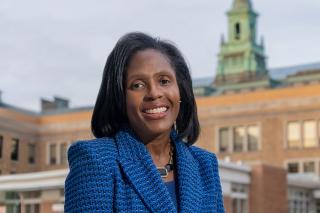Today is Equal Pay Day, where we acknowledge the stark and troubling reality that women still lag behind their male counterparts when it comes to that all important paycheck. Women, on average, are only paid 77% of every dollar paid to white men – meaning they have to work an additional two and a half months to reach the same pay that men earn in one year.
It is even worse for Black women, who are paid 64% of every dollar paid to white men, Latina women who receive 54%, and Native women who are paid only 51%. It is also worth noting that mothers receive 62% of every dollar paid to men with children.
These numbers showcase just how far we have to go to achieve pay equity. As the president of an institution that has historically prepared women for the professions, I understand the powerful role women's colleges have in raising awareness of and addressing this challenge.
Simmons University was founded for equality more than 120 years ago by clothing manufacturer John Simmons, who directed the college to provide an education “best calculated to enable the scholars to acquire an independent livelihood." Some of the other 28 existing women's colleges in the United States are also focused on professional preparation, while others have a traditional, liberal arts orientation. Whatever their focus, these institutions are united in their ability to educate and empower students in an environment uniquely suited to helping women recognize their strengths and find their voices.
The statistics tell a powerful story. Women's college graduates are more likely than graduates of public co-ed universities to say that college prepared them for their first job, and they are also more likely to complete a graduate degree.
Women's colleges are also particularly good at creating an inclusive model for success. According to the most recent College Scorecard data, women's colleges have higher enrollments of students of color, and students of color have higher graduation rates at women's colleges than at co-ed colleges. Women's colleges also have a higher graduation rate among both Pell-eligible students and first-generation students than co-ed colleges.
Just as important, graduates of women's colleges have a higher median income ten years after graduation than graduates of co-ed colleges – meaning women's colleges are a key tool to reduce the gender pay gap.
Unfortunately, women's colleges are becoming an increasingly endangered species. In the 1960s, there were over 200 women's colleges in the United States. Today, there are about 30. In just the past few years, we have seen the historic Judson College in Alabama close, Mills College in California merge with a larger, co-ed university, and Converse University in South Carolina and Notre Dame of Maryland University announce they were going co-educational.
Even though women are no longer excluded from American universities, women's colleges still offer a refuge for students who are looking for a community that is uniquely suited to recognize their needs and experiences, while fostering the skills they need to be leaders in their communities and workplaces.
The students I know who have graduated from women-centered college are confident, prepared leaders who have a keen sense of their own identities and of the changes they want to see in the world. That is why we can and should do more to support these vital institutions. Women's colleges need the kind of targeted resources and federal support that Historically Black Colleges and other Minority-Serving Institutions receive.
Women's colleges are best suited to address some of our most persistent economic and social challenges – particularly as it relates to pay equity, the She-Cession, and the lack of women in top executive positions. Our current and future graduates will be at the forefront of creating inclusive solutions for a whole range of issues in healthcare, education, and more. So let's work together to ensure these institutions have access to the resources they need. Our students and our nation deserve nothing less.

